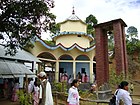Meitei architecture

Meitei architecture or Manipuri architecture is the architecture produced by the Meitei speaking people, whose culture flourished in the Kangleipak kingdom and its neighbouring kingdoms from the middle of the fifteenth century BC. The Meitei architecture is best known for its temples (Laishang, Kiyong, Thellon), found scattered in the Kangleipak (present day Manipur). Other architectural forms that are still in existence are the grand gates (Hojang), Traditional houses (Yumjao), Public houses (Sanglen), Official buildings (Loishang), etc.[1][2]
Influence[]
Due to the arrival of Hinduism in the kingdom of Kangleipak (present day Manipur), the form of architecture was greatly influenced during the 16-17th century AD. Hundreds of Vaishnava temples were built in the kingdom with a mixed architectural design of both the traditional Meitei architecture and Mainland Indian architecture.[3]
Styles[]
The temples and other buildings built in Meitei architecture is easily distinguished by the Holy Chirong (horns), attached on the top of the roof. Some of the significant examples are easily seen in the Hiyangthang Lairembi Temple and .[4] There are styles of engraving animal figures on the walls of the buildings, especially the figures of bulls, Buffalo, etc. are mainly found.[5]
Gallery[]
A Vaishnava temple at Imphal

A Hindu temple at Kakching Khunou, Manipur

A Hindu temple at Imphal
The Western Gate of Kangla Palace, Imphal

The ruins of old temple inside the Kangla Palace, Imphal

A Meitei Hindu temple at Ningthoukhong, Manipur

Old ruins at Kangla Palace

Bihu Loukon, aerial view

Grand gate of Shrine of Lord Khamlangba, with a holy horn in the top

A Hindu temple in Meitei style at Kakching
See also[]
References[]
- ^ "Scientific Principles of Ancient Manipuri Yumjao House and its Courtyard By Khwairakpam Gajananda". www.e-pao.net.
- ^ [1][dead link]
- ^ "The Vaishnava Temples of Manipur: An Historical Study". Sahapedia.
- ^ "SANAMAHI KIYONG TEMPLE - India". IMPHAL EAST DISTRICT, GOVERNMENT OF MANIPUR. 2018-07-20. Retrieved 2020-11-17.
- ^ "Arts and Architecture of manipur". Webindia123.com.
- Indian architectural history
- Indian architectural styles
- History of Manipur
- Meitei culture










